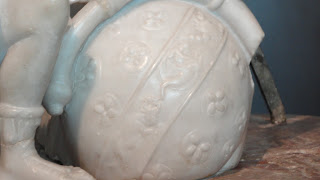Alright, now that you understand my classes, you can figure out that during the week it's usually pretty calm. No crazy adventures, not many new discoveries, just hard work and everyday life..
But the WEEKENDS... well there's something different.
Friday:
We went to Musei Capitolini!
Absolutely one of my major reasons for loving Rome so much is the art! It's absolutely incredible, and it was SO much fun getting to see the (mostly) marble sculptures in this museum.
The museum is itself two different buildings across a courtyard from each other which are connected by and underground passage way.
So there is far FAR too much art to share in a blog post, and unfortunately my memory is terrible... but here are a few pictures of things I loved, and can remember some about!
This GIANT head, is a piece of a broken statue of Constantine. There was also his foot, bicep, knee cap, and other parts that were left from this statue. When you are standing next to them you can see how enormous this statue must have been...
Here is his foot:

THIS is Bernini's statue of Medusa:
This statue was extremely interesting to me, because of what it is actually depicting.
Medusa is the woman from the myth with snakes as hair...Here is her story:
Medusa was once an ordinary woman, who was VERY beautiful. Her hair especially was spectacularly gorgeous. Beautiful, and vain. Medusa KNEW how beautiful she was. Medusa was so vain, she constantly admired herself, and commented on how beautiful she was. One day this vain woman dared say that her hair was even more beautiful than the goddess Athena. When Athena heard this, she was furious, and decided to teach this Medusa a lesson. Athena turned Medusa into a monster, and her hair turned into snakes upon hear head.
Along with this curse, Medusa was given eternal life, destined to live out her misery as a monster until the day someone (eventually Perseus) beheaded her.*
Cool story right? Well, this statue here is the very MOMENT where Medusa's hair is being transformed. You can see the agony on her face as she realizes what is happening, a beautiful ordinary woman (though perhaps she was more vain than the ordinary woman) watching in a glass as she is changed into a monster and she can do nothing about it.
In this slightly closer shot you can see how we know it is the moment of her transformation.
Though the top of her head has mostly transformed already, you can still see her ordinary hair, just beginning to morph into live snakes, by her left cheek.
Anyway, I just loved this story, and I thought the art was beautiful.
* There are other versions of this story as well,
but this is the one that our guide told us.
NOW, this next statue I will share was also a big interest to me, mostly because I love the movie Gladiator!
This is a statue of Commodus. Yes, this is how the real Emperor Commodus wished to be portrayed in art, for everyone to see and remember:
Actually, the movie (Gladiator) was apparently fairly accurate in its portrayal of his character (though his actions weren't quite accurate: he did NOT kill his father, and actually reigned about 12 years, not 3 or 4 like the movie makes it seem like).
Well, like I said, they got his character right.
This sculpture is very meaningful, and shows a lot about his true character...
The lion head he is wearing, and the three apples(?) he is holding, along with the club are common in statues of Hercules. In other words, Commodus wished to be portrayed as a new Hercules (who, if you don't know the story at all, became a God after triumphing over 12 trials.)
The ball at the very base of the statue (I'll show it below) is also very significant and tells a lot about how Commodus saw himself...
This sphere has a band going around it (you can see it a little, but not too clearly) and in the band are various constellation signs. Thus, we can deduct that the sphere is a representation of the universe. Clearly Commodus wanted to be in charge.
So now, we have an accurate representation of the wanna-be "god-man" Commodus.*
*There are more symbols in this statue, but I don't exactly
remember what they are, and I'm sure
you get the point by now. ;)
And of course, I can't leave out Marcus Aurelius:
This statue is made of bronze, but when the restoration workers were cleaning it up, they discovered that it had at one time been gilded, showing that this was even more precious than it had previously been thought to be.
Surprisingly though, it was only by a (rather fortunate mistake that this statue was preserved at all. After Rome had become largely Catholic, many secular things were not preserved. This statue survived because it was originally thought to be Constantine (who was praised for making . However, it is now known that Constantine was never depicted with a beard (remember the giant head in the beginning-- no facial hair). Marcus Aurelius however, DID have a beard.
Well, I guess I'll stop here, there are so many more cool art things to share, and I still have to tell you about my Friday, but that can wait until tomorrow :)
Talk to you later!




























